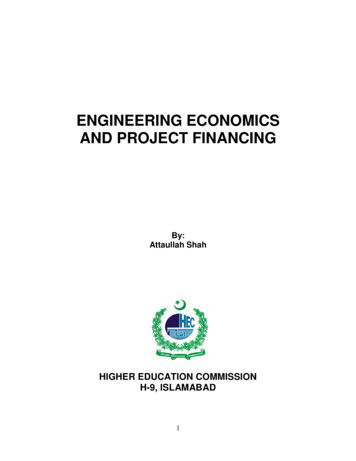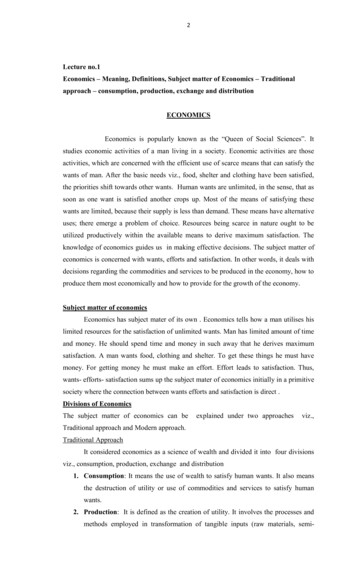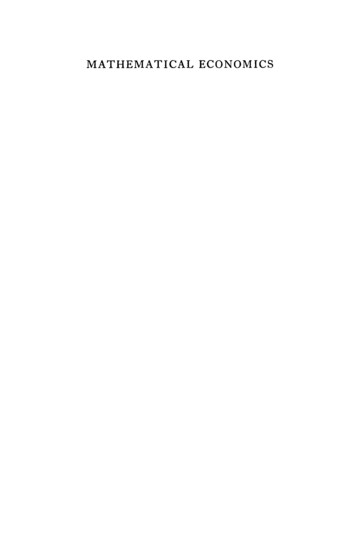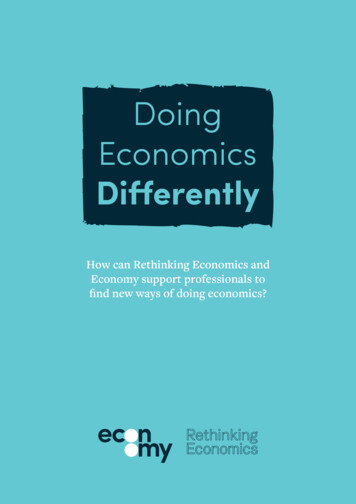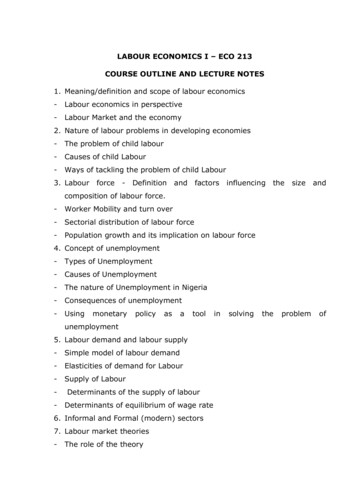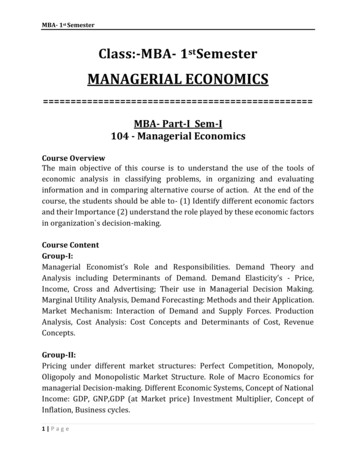
Transcription
Bettina FuhrmannIntroductionto Businessand EconomicsWU Bachelor Program Business and Economics –Study Material for the Entrance Exam
Foreword and acknowledgementsThis script has been written for students who are interested in the English WU bachelorstudy programme Business and Economics and want to take the entry exam. The contentof this script has been taken from the book Fuhrmann, Bettina: Introduction to Business andEconomics. Verlag Jugend & Volk, Wien, 2019. It is the aim of this book to explain some basic concepts of business and economics and their interrelationships to those who are interested but have little previous knowledge of business matters and economic issues. Asboth business studies and economics are comprehensive, multifaceted and interdisciplinary scientific fields, a short introduction can only cover selected topics. Nevertheless, it isthe intention of this short introduction to provide a solid basis on which to build moreknowledge as well as to spark an enduring interest in business and economics and motivate readers to learn more.Such a textbook – no matter how many pages it has – always profits from feedback fromother business teachers who are experts in their respective fields. I consider myself verylucky to have colleagues who have done so and contributed to the development of the text.Therefore, I would like to thank (in alphabetical order)Nora Cechovsky, Jesus Crespo Cuaresma, Ingrid Dobrovits, Eva Eberhartinger,Richard Fortmüller, Gerhard Geissler, Edith Littich, Harald Oberhofer,Rupert Sausgruber, Christiane Schopf, Gerhard Speckbacher,Rosanna Steininger, Barbara Stöttinger and Julia Szoncsitzfor their valuable comments on the manuscript.I would also like to thank my family for letting me work on the book not only during countless evenings but also on weekends. As it is my firm belief that economic knowledge is ofutmost importance to each and every person regardless of his or her age, gender, or personal background, I dedicate the book to all young learners who should understand – thesooner the better – that they are all an active part of the economy and there is no optingout of economic decisions.Bettina FuhrmannDirector of the Institute for Business EducationVienna University of Economics and BusinessVienna, 20192I N T R O D U C T I O N TO B U S I N E S S A N D E C O N O M I C S
Contents1. Introduction to business matters42. Basic economic concepts72.1 Being part of the economy2.2 Scarcity of resources and opportunity cost2.3 Economics is the study of economic decisions2.4 Exchanging goods and services creates a circular flow and division of labour2.5 Different economic systems2.6 Supply and demand: households, businesses and the government meet in themarket2.7 Competition in the market3. Focus on different types of businesses3.13.23.33.43.53.6Businesses combine different factors of productionBusinesses operate in the primary, secondary and/or tertiary sectorBusinesses can be profit-oriented or not-for-profitBusinesses come “in all sizes”: large and smallBusinesses may be local, national or internationalBusinesses operate in an environment – stakeholders are important4. Forms of business ownership and sources of finance4.14.24.34.44.54.6Sole proprietorship / sole tradersPartnershipCorporationsSummary: Overview of forms of business ownershipOverview of sources of financeThe choice of the source of finance5. Marketing5.15.25.35.45.55.65.7What a product isObjectives of marketingProduct orientation versus market orientationThe need for more responsibility and sustainabilityMarket researchMarket segmentation and targeting strategiesThe marketing mix6. Accounting – keeping record of business transactions6.16.26.36.46.5What a balance sheet isOther components of the financial statement of a businessWhat can be learnt from reading a balance sheet and an income statementUse of these accounts – types of accountingAnalysis of financial 31313233333739505052555859 to be continued in the book7. Personnel management – because people matter8. Writing a business plan9. Case studyI N T R O D U C T I O N TO B U S I N E S S A N D E C O N O M I C S3
Introduction to business matters1Introduction to business mattersOver the past few years Tina has noticed thatquite a lot of people buy new computers eventhough their old ones are still working. At thesame time other people are perfectly happy with aused computer as long as it works. They do notneed to have the latest model, they are just interested in having access to the Internet and thecomputer programs that they want to use. What ismore, many people need help to get started withtheir new computer, and some also need help later on with new releases of software, datastorage and security issues.At school and also later during their university studies, Tina and her former classmateSteve specialised in computer science and in business. They have always tried to help theirfamilies and friends with any computer issues. And as more and more friends of theirfriends as well as neighbours and acquaintances of their families have asked for help,they have considered starting a businessthat offers a wide range of professionalcomputer services.A business is an entity that offers goodsand/or services to customers. Businessesdo not produce primarily for their own needsor work exclusively for their families’ andfriends’ needs, but for someone else: for their customers. Businesses usually charge aprice for their goods and services so that they get something in return. Exchanging goodsand services against money or other means of payment (or exchange) is a maincharacteristic of the economy.Tina and Steve consider the following idea: buying used computers at a low price, checkingand repairing them (if necessary), and adjusting/modifying them to the needs and wishesof their customers. By doing so, Tina and Steve are able to offer ready-to-use computers atan affordable price and create value for their customers.They also consider offering additional services such as setting up the computer at the user’s home, installing software, connecting the computer to the Internet, explaining how touse the computer etc. Another idea that comes to their minds is offering online help forproblems that might occur. Customers facing a problem with their computer would be supported within 24 hours. Tina and Steve are even considering developing tailor-made software for their customers. With so many ideas, Tina and Steve are convinced that they canstart a profitable business. That is exactly what they want to do as they need to earn money to make a living.4I N T R O D U C T I O N TO B U S I N E S S A N D E C O N O M I C S
Alternatively, Tina and Steve could easily find jobs that they are interested in because theyboth have a profound knowledge of business and computer science. During their studiesboth of them worked for AT&S, the Austrian company Austria Technologie & SystemtechnikAG, for a couple of months and they liked that very much. AT&S (https://ats.net/de/) is amanufacturer of high-end printed circuit boards and of new technologies such as IC substrates, mSAP and advanced packaging. It is located in Styria with some production sitesin Asia and ranks among the globally leading companies in that field. In Europe, AT&S isthe market leader, with revenue of about 990 million and almost 10,000 employees.However, at the moment, they both prefer the idea of being self-employed, generating theirown ideas, creating something new and being their own bosses. They prefer to becomeentrepreneurs who have developed an idea, solve problems and create value for theircustomers, take a risk and make sensible economic decisions.They consider further aspects about founding their business. They are ready to work longhours and invest their savings in the business. They have found a business location thatthey consider appropriate, where they could rent two rooms in an office building for meeting with customers, working and developing software, storing the computers and otherequipment. Additionally, they would need a car or – even better – a small van that theywould use for transporting the computers between their customers and their office. Tina’scar, which she does not really use very often, could be used for that purpose, at least forthe first few months. Yet, they know from what they have learned during their businessstudies that there are a few more questions to be considered. The following chapters coverthe basic knowledge that is needed for answering these questions.Important questions to be considered before setting up a businessQuestionsWhich people and organisations have an interest in the business and/or are influenced by Tina’s and Steve’s businessactivity?How does Tina’s and Steve’s business influence the environment and the economy?What kind of business will Tina’s and Steve’s business be?covered in chapterChapter 2Basic economicconceptsChapter 3Focus on differentkinds of businessesTina and Steve work as a team, so which legal form shouldtheir business have?Do Tina and Steve have enough funds to finance their business? What sources of finance could and should they use?Chapter 4Forms of businessownership andsources of financeAs they will have bills to pay or might have to repay a loan,how can they make sure that they have the funds for thatand who will be liable for these payments?I N T R O D U C T I O N TO B U S I N E S S A N D E C O N O M I C S5
Introduction to business mattersWhat exactly do their potential customers want and need,and how can these needs be addressed? Will there be (continuous) demand for what they want to offer?Chapter 5MarketingHow many people could potentially be interested in their offer (market potential), and are there any competitors in themarket?How much would people be willing to pay for their productsand services and in which way would this price be affected ifthe market changed?How can a business communicate its offer to its potentialcustomers?How will Tina and Steve know that their business is thriving?How will they know if their financial situation is solid?How will they know if their business not only generates profitbut also turns profits into cash?Chapter 6Accounting –keeping recordof businesstransactions to be continued in the bookChapter 7Personnelmanagement –because peoplematterChapter 8Writing abusiness planChapter 9Case studyAs Tina and Steve are thrilled about their business idea, they cannot wait to find answersto all these questions.6I N T R O D U C T I O N TO B U S I N E S S A N D E C O N O M I C S
2Basic economic conceptsBefore going into details about what a business is and how it is run, it is necessary to understand the business environment, and the economy that it becomes a part of. and It isalso important to understand some basic economic concepts that have an influence on theeconomic decisions not only of businesses but also of individuals, such as what to offer (tosell) and what to purchase, how to manage the available resources and how to finance theexpenditures.2.1 Being part of the economyBy running a business, Tina and Steve are an active part of the economy as entrepreneurs.Businesses provide goods like computers and services like installing software for peoplewho need these goods and services to satisfy their needs. Their needs might include havinga computer as well as getting technical support. Not only individuals, but also businesseshave needs: manufacturers of smartphones, tablets and laptops might need the printedcircuit boards (PCBs) that are produced by AT&S. In turn, AT&S needs raw materials and aworkforce to produce these PCBs. And individuals might also exchange goods and serviceswith each other, like selling a house, an apartment or a used car, or exchanging vegetablesor flowers from the garden and getting a bottle of wine in return. In the economy, peopleand businesses exchange goods and services to fulfil their needs and wants.Therefore, Tina and Steve were part of the economy a long time before starting their business. As individuals, they have been part of private households and have bought goods andservices from a wide range of businesses. Like thousands of other households, they needfood, a home to live in, medical care, a car and/or other kinds of transportation, they want todo sports or go to the cinema, to a café or a restaurant. Businesses offer the goods and services that people (as part of private households or other businesses) need and/or want. Exchanging would be much easier if all that we want or need is available inabundance, but that is not the case. Resources are scarce and need to be managed. This is why we all need to economise. No one is able to opt out of makingeconomic decisions.2.2 Scarcity of resources and opportunity costBoth households and businesses only have limited resources to pursue their goals: businesses have a certain number of machines and tools and a limited amount of material andfinancial resources to produce their goods and provide their services. Likewise, householdsonly have a certain income that they are able to spend on purchasing goods and services,with maybe a part of that income left for saving. Resources are always scarce, and thisscarcity of resources forces businesses as well as individuals to make decisions on how touse those limited resources: what and how to produce, what to buy, how much to spend.It is a basic economic problem of households, businesses and the government to decidehow to use their limited resources and to make choices when allocating these scarce resources between different options. Tina and Steve can either found their own business orthey can take jobs at another business and become employed. If they earned 35,000 eurosI N T R O D U C T I O N TO B U S I N E S S A N D E C O N O M I C S7
Basic economic conceptsper year in such a job, this 35,000 euros would be their opportunity cost per person if theydecided to set up their own business. If they took these jobs, they would also have opportunity cost: the amount of money that they could have earned with their business. Of course,it would be difficult to tell how much that could have been. Opportunity cost is the (financial) benefit of the (next best) alternative that is lost or given up in order to choose orachieve something else.2.3 Economics as the study of economic decisionsEconomics is the study of how individuals (as part of private households) and businesses make decisions to satisfy their needs and wants with limited resources. Itcomprises a number of scientific fields and branches, two of which are microeconomicsand macroeconomics. Microeconomics focuses on the behaviour and decisions of individual households and businesses and how they interact. A question in microeconomics couldfocus on the change in demand of electric cars if buyers of electric cars receive a bonus. Incontrast, macroeconomics looks at the bigger picture and deals with questions concerning the overall economy (of one country for example) and aggregate quantities. Amongother phenomena, it studies economic growth, unemployment, interest rates, price levelsand inflation. As a science, economics strives to explain the observed phenomena and alsoto make predictions, both based on various theories.2.4 Exchanging creates a circular flow and division of labourWhile households mainly offer labour and receive wages, businesses offer goods and services that are bought by households and other businesses and receive money for what theysell (see figure 1). This is how a circular flow of goods, services and money is created. Asmoney is used as a means of exchange that is widely used and accepted, these exchangescan be carried out relatively easily. Without money, people would have to barter, which ismuch more complicated. If you want to acquire a good from another person, but do nothave what this person wants in return, there will be no exchange. Money allows for a flexibility of exchange (first function: medium of exchange).It also allows us to express the value of things (second function: unit of account) and to store value over time (third function: store of value).Money fulfils these functions best if its value remains pretty stable over time. However, ifthere is a general rise in prices of goods and services, you can only buy a lower amountof goods and services, which means that the purchasing power of money (i.e. its value)declines.Price indexes allow us to measure the extent of this general increase in prices, a phenomenon that is also called inflation. Low inflation rates can be tolerated. The European Central Bank considers an inflation rate of slightly below 2% per year most beneficial to theeconomy. But if inflation rates are considerably higher, the purchasing power of moneydecreases considerably. As the amount of goods and services that can be bought for acertain amount of money continuously decreases, people lose their trust in money and tryto get rid of it.8I N T R O D U C T I O N TO B U S I N E S S A N D E C O N O M I C S
In the circular flow of the economy (see figure 1), public authorities (mainly governments)also play an important role. They levy taxes from households and businesses and use themoney to provide goods, transfer payments and subsidies. Such goods as infrastructure(e.g. streets and street lights) and services like national defence and public security (e.g.police) need to be provided by governments and financed by taxation. There is demandfor these goods, but private businesses would not want to supply them as “free riders”(people who do not pay for a good or service) cannot be excluded from enjoying them. Inmany – but not all – countries health care and education are also provided (at least to alarge extent) by public authorities.rvi(public ds, sesxeGoods, servientsaymndranpersfGoods and agesFigure 1. The circular flow of goods, services and money within the economyDivision of labour and specialisationWithout exchange of goods and services, individuals would have to produce everythingthey need themselves. That would be very difficult, time-consuming and inefficient because they would have to spend time on performing tasks that they lack the skills for. Exchanging goods and services allows for the division of labour and therefore specialisation.Individuals and businesses can concentrate on what they can do best. This explains thewide variety of jobs and of businesses. Using a widely accepted means of exchange likemoney facilitates the exchanges.Specialisation can be found on many levels: Within households, for example where individuals can concentrate on what they cando best or what they like doing (like one individual does the shopping, the other one thecooking). The same principle applies to businesses: within businesses, some people concentrate on production, others on procurement, some others on sales, on recording allI N T R O D U C T I O N TO B U S I N E S S A N D E C O N O M I C S9
Basic economic conceptsfinancial transactions or on managing human resources. Accordingly, these (different)tasks of a business are often summarised in different departments of a business: procurement, production, sales department, marketing, finance and accounting. Specialisation can also be found between businesses as every business focuses on aspecial range of products: some offer all kinds of furniture, others just beds and couches, some others just produce kitchens. These businesses operate on the same level ofproduction. But specialisation can also be based on division of labour between businesses on different levels of production (first level: production of wood and iron, second level: production of boards and nails, third level: production of tables, final level:selling them) or in different sectors of the economy (see chapter 3). Specialisation can also be found on an international level, as countries differ in climate, natural resources, geographical position and many other characteristics. Dueto very different characteristics, countries also differ in their conditions for differentindustries (industry being a number of businesses that produce or sell the same product) and different business functions. AT&S for example has production sites in Europeas well as in Asia (China, India and South Korea). While production in Europe is highlydiversified and relatively low in volume, production in Asia reaches a much higher volume but has a lower product diversity. This kind of division of labour can be explainedby differences in terms of know-how of the workforce, labour costs, availability of otherresources and the legal framework in different countries.While division of labour has many advantages, it also has some disadvantages that needto be considered: for very specialised workers, work may become boring over time. Beingspecialised also means less flexibility as it is hard to develop other skills or develop competencies in other fields. A specialised business may be brilliant in that field, but if – forsome reason – that specialisation is not needed anymore, the business is at risk and people could lose their jobs.2.5 Different economic systemsThe role of governments described above is mainly true for the governments in some sortof market economy. While in market economies individuals and businesses are – more orless – allowed to make many of their own economic decisions, in planned economic systems the governments play a dominant role. They (mainly or partly) decide which goodsare produced and which services are offered (at which prices). Furthermore, they (mainly orpartly) control the resources and the means of production. People have a limited choice ofwhich job to do and which products to buy.In most countries of the world, economies can be characterised as some kind of marketeconomy. In some of these countries, the governments play a minor role by only providingthe legal framework and not influencing the economy much, so their economic systemcomes close to what is called a “free market economy”. In many other countries, the government plays a more important role by influencing the economy to a somewhat higherextent, by supporting the poor and protecting the environment for example. These systemsare called “social market economies” or “eco-social market economies”.Over the past decades, a lot of former communist countries that used to have plannedeconomic systems have adopted the main principles of the market economy. Many Centraland Eastern European Countries (CEE), China and former Soviet countries are examples ofsuch a transformation.10I N T R O D U C T I O N TO B U S I N E S S A N D E C O N O M I C S
2.6 Supply and demand: Households, businessesand the government meet in the marketIn a market economy, goods and services are offered and sold on/at markets. Buyers andsellers meet to communicate the conditions of exchanging goods and services and thusform a market. A market can be an actual place, like a flower market in the city of Rome ora flea market in a small village, but it can also be a virtual place like a market on the Internet (e.g. eBay, Amazon). Buying and selling take place in shops, but also on the phone.Therefore, there are many different markets, also depending on what is offered: consumergoods markets, labour markets (supply and demand for work), housing markets, moneymarkets, capital markets, commodity markets (supply and demand for raw materials).2.6.1 The law of supplySupply (of a certain good or service) is the quantity of that good or service that isavailable for purchase. Basically, this quantity mainly depends on the businesses’ production capacities and the available resources, but also on the price that can be chargedfor the good or the service. The higher this price is, the higher the supply will be. Allother things held constant (“ceteris paribus”), this relationship is true for most goods andservices in the economy (law of supply).In Tina’s and Steve’s case, the quantity of hours that they (as well as other providers ofsimilar computer support services) are willing to work depends on the price they can chargeand that will be paid. It is tiring work and the providers of this service need to be veryskilled. If the price is low, let’s say below 30 euros per hour for example, no provider wouldoffer that service. The opportunity cost would be too high: as the providers are very skilled,they could earn more money by doing something else (that is also less tiring), so they wouldleave this market and offer another kind of service. The higher the price, the higher thenumber of hours that would be offered. More potential providers would enter the marketand would be willing to offer a higher number of hours of their service.The shape of the supply curve can also be explained by the concept of increasing marginalcosts faced by many industries and businesses. Marginal cost is the cost of producing anadditional unit of a good or by providing an additional unit of a service. As output increasesand exceeds a certain level it will become more and more costly to produce; businessesneed to build higher capacities (machinery, personnel) so marginal costs would rise. Only45Supply per week40Quantity35302520151050050100150PriceI N T R O D U C T I O N TO B U S I N E S S A N D E C O N O M I C S200250Figure 2. The supply curve(price in euros, quantity in1,000 hours)11
Basic economic conceptsif the price level increases and exceeds (or at least equals) marginal costs would businesses be willing to produce and supply a higher amount.Figure 2 shows the relationship between prices and supply in the market for computer support services (e.g. within a country).2.6.2 The law of demandDemand, on the other hand, is the quantity of a good or service that customers arewilling and able to buy. Usually the higher the price is, the lower demand will be. Themore Tina and Steve as well as other providers charge for their technical computer supportservice per hour, the more demand will decrease (because more and more people cannotafford such high prices or are not willing to pay such high prices for that service and willinstead look for other ways to get help with their computer problems). People’s willingnessto pay a certain price is related to the utility or the level of satisfaction the people get fromconsuming the service. Figure 3 gives you an idea of how many hours of technical supportwould be demanded in the market, depending on the price.100Demand per 0Figure 3. The demand curve(price in euros, quantity in1,000 hours)The graph in figure 3 shows that the quantity demanded decreases as the price rises. Accordingly, the quantity demanded (the quantity that people are willing and able to buy) increasesas the price falls. Therefore, the quantity demanded is negatively or inversely related to theprice. All other things equal (“ceteris paribus”), this relationship can be found with almost allgoods and services in the economy, so that it is also called the law of demand.2.6.3 The market equilibriumIf we have a look at both curves, we can see that they intersect at a certain point, at theprice of 150 euros. At this point, the quantity of hours that is demanded in the marketequals the quantity of hours that is supplied.Assuming that these curves represent supply and demand in the whole market for computer support services, this price would also be called the market price or equilibrium price(because supply equals demand). At the price of 150 euros per hour demand and supplybalance each other out. As the quantity supplied equals the quantity demanded, there isneither a surplus (higher supply than demand) nor a shortage (higher demand than supply).At a higher price, demand would be lower than supply and vice versa.12I N T R O D U C T I O N TO B U S I N E S S A N D E C O N O M I C S
100Supply and 250Figure 4. Supply anddemand intersect at themarket price (price in euros,quantity in 1,000 hours)In the real world, other factors than price also affect demand and supply.Demand is also affected by: Changes in income: If income increases, people can afford more (and more expensive) computer services and – all other things held constant – demand would increase(so the demand curve would shift to the right). Similarly, if income decreased, peoplewould not be able to spend so much money on technical support anymore, and consequently, demand would decrease (and the demand curve would shift to the left). Changes in consumer preferences: More and more people might want to have additional technical support, so demand would increase. In a different scenario, peoplecould possibly like to have new and faster computers, so demand for used computerswould decrease (regardless of the price). Complementary goods: If an additional service is offered that is related to the computer support service and that people are highly interested in, demand for computerservices would be very likely to increase. The availability of substitute goods: If people found a service that perfectly substitutes computer support services, the demand for computer support service offerswould also decrease. This effect will also be discussed in chapter 5, Marketing.Supply is also affected by: Number of suppliers: The more profitable a market is considered to be, the more suppliers will enter this market. As the number of suppliers increases, supply will increase(the supply curve would shift to the right), until supply is so high that prices fall againand no more additional suppliers enter the market. Technological changes: These might enable more people to provide computer services and enter the market. Changes in resource prices: If the costs for offering the s
INTRODUCTION TO BUSINESS AND ECONOMICS 3 Contents 1. Introduction to business matters 4 2. Basic economic concepts 7 2.1 Being part of the economy 7 2.2 7Scarcity of resources and opportunity cost 2.3 8Economics is the study of economic decisions 2.4 Exchanging goods and



